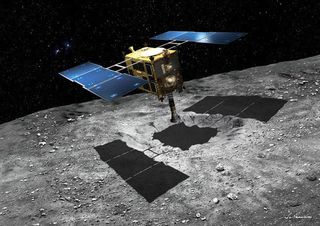Japan's Hayabusa2 asteroid sample-return capsule cleared for landing in Australia
It arrives with samples of asteroid Ryugu on Dec. 6.

Japan's asteroid-sampling mission is officially clear to return its precious cargo to Australia in December, according to statements from both countries' governments.
The Hayabusa2 spacecraft is trekking back to Earth with a sample capsule full of material snagged from a near-Earth asteroid called Ryugu. The Japan Aerospace Exploration Agency (JAXA), which runs the mission, has long planned to deposit that capsule in the vast desert of Australia, but the new announcement marks that country's official approval of the plan.
"I am delighted to have given the tick of approval for the Hayabusa2 to land at the Woomera Prohibited Area and am thrilled JAXA has chosen to partner with us on the capsule's re-entry," Karen Andrews, Australia's Minister for Industry, Science and Technology, said in a statement. "This mission is a very important scientific and technical feat, as the first ever sub-surface asteroid sample to be returned to Earth."
Related: Touchdown! Incredible photos show 2nd asteroid landing by Japan's Hayabusa2
Over the course of its stay at Ryugu, Hayabusa2 collected samples from the asteroid's rocky surface, shot the asteroid to create an artificial crater, and collected some of the subsurface material uncovered by that impact as well. The diversity of samples means that scientists will be able to learn more about Ryugu's interior and how it has responded to the harsh forces of outer space, like the solar wind, a constant stream of highly energized particles called plasma flowing off the sun.
But even with advanced spacecraft, scientists can always do more detailed analyses in laboratories on Earth, hence the need to land that capsule. Hayabusa2's predecessor, another asteroid sample-return mission called Hayabusa that visited a space rock called Itokawa, also returned its material to Australia, and the current mission will follow suit, with the deposit scheduled for Dec. 6.

"The approval to carry out the re-entry and recovery operations of the Hayabusa2 return sample capsule is a significant milestone. We would like to express our sincere gratitude for the support of the Australian government as well as multiple organizations in Australia for their cooperation," JAXA president Hiroshi Yamakawa said in a statement. "We will continue to prepare for the successful mission in December 2020 in close cooperation with the Australian government."
Get the Space.com Newsletter
Breaking space news, the latest updates on rocket launches, skywatching events and more!
However, unlike Hayabusa, the current spacecraft will not return in full; it will only deposit a sample capsule back to Earth. JAXA is evaluating sending the Hayabusa2 probe on to visit a second asteroid about a decade from now.
Email Meghan Bartels at mbartels@space.com or follow her on Twitter @meghanbartels. Follow us on Twitter @Spacedotcom and on Facebook.
Join our Space Forums to keep talking space on the latest missions, night sky and more! And if you have a news tip, correction or comment, let us know at: community@space.com.

Meghan is a senior writer at Space.com and has more than five years' experience as a science journalist based in New York City. She joined Space.com in July 2018, with previous writing published in outlets including Newsweek and Audubon. Meghan earned an MA in science journalism from New York University and a BA in classics from Georgetown University, and in her free time she enjoys reading and visiting museums. Follow her on Twitter at @meghanbartels.
